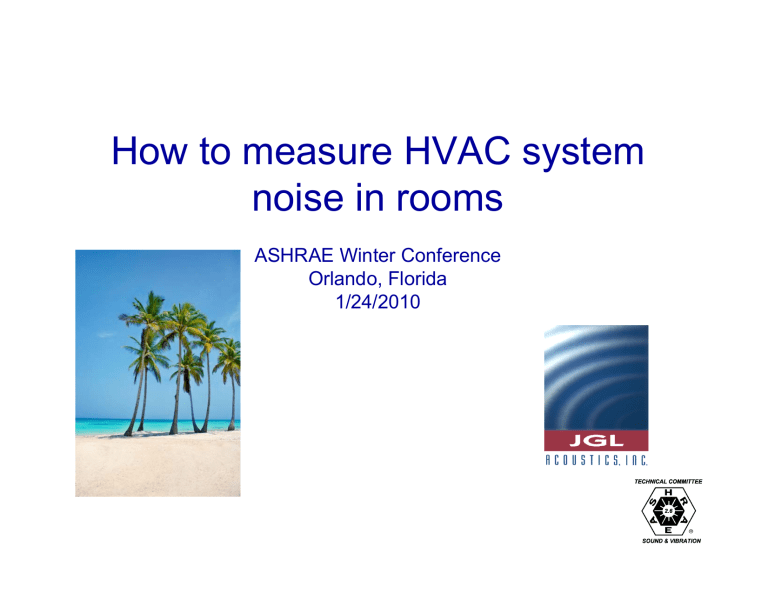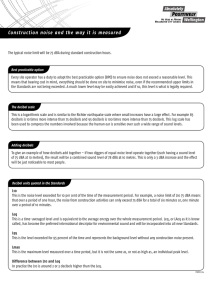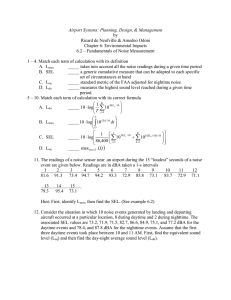How to measure HVAC system noise in rooms

How to measure HVAC system noise in rooms
ASHRAE Winter Conference
Orlando, Florida
1/24/2010
Jerry G. Lilly, P.E.
JGL Acoustics, Inc.
Issaquah, WA, USA jerry@jglacoustics.com
Learning Objectives for Seminar #1
• To understand acoustic measurement protocols for the operational performance measurement of occupied commercial buildings.
• How to take noise measurements in a room.
• To understand how to benchmark the acoustic performance of green buildings.
• To communicate a basic understanding of the acoustical measurements used in the three levels of the PMP.
• How to use the Innovation in Design Credit process for application to superior acoustic design and performance.
• How standard architectural design currently performs relative to the occupants perception of acoustic satisfaction in buildings.
HVAC System Noise
• HVAC system noise represents only a part
(but an important part) of the acoustic measurements identified in the PMP
(Performance Measurement Protocol)
• Other acoustic issues relate to: reverberation control sound privacy speech intelligibility
Why is HVAC System Noise
Important?
• Excessive noise can impact speech intelligibility
• Excessive noise can cause occupant annoyance
• Excessive noise can impact worker productivity
• Too little noise can impact speech privacy
Measurement Standards
• There is no current ANSI standard that provides specific direction on how to measure noise levels in rooms
• There is a new ANSI working group
(S12,WG-51) that has the goal of developing such a standard
PMP (Acoustics)
Level
Basic
Intermediate
Advanced
Measurements
Background Noise
Background Noise
& Reverberation
Time
Intermediate +
Sound Privacy &
Speech
Intelligibility
Metrics dBA (L eq
)
NC, RC, NCB
(octave bands)
AI, PI, SIL,
NIC, IIC
Instrumentation - Basic
• Sound Level Meter
• Hand held (tripod)
• ANSI S1.4 (Type 1 or 2)
• 20 Hz to 20,000 Hz
• Noise floor <25 dBA
• A & C Weightings
• L eq
, (L max
)
• Digital Display
Instrumentation – Basic Setup
• Calibration (annual and on-site)
• Set frequency response to 20 Hz to 20,000 Hz
• Set range to avoid overloads, if necessary
• Set filter to A-weighting
• Set display to L eq
• Set meter to random incidence
Noise Level Variations
• Background noise level varies with location in room and with time.
• Time and space variations can be resolved by averaging
(L eq
)
• The L eq is the timeaverage sound level over a specified time period (1-sec to 1 hr)
Spatial Variations
• Average (L eq
) noise levels will be up to 3 dB higher close to a room surface,
• up to 6 dB higher close to an intersection
(wall-floor, wall-wall, or wall-ceiling),
• up to 9 dB higher in a corner.
Allowed Measurement Locations
• Any point in the room more than 1 meter from a room surface, except:
not closer than 0.5 m from objects
not more than 2 m above the floor
not closer than 1 meter from a noise source
(e.g., diffuser, exposed HVAC equipment)
Preferred Measurement Location
• The allowed measurement location that:
has the highest sound level, and/or
is the most likely location for the most sensitive occupant’s ears.
For example, in a classroom the student’s desk that is farthest from the teacher
Taking the data (part 1)
• Close all doors and windows, unless open windows are required for ventilation
• Listen for extraneous noise sources and note or turn OFF, if possible
• Survey the room by slowly walking around and listening to the background noise
• Note any high noise areas
Taking the data (part 2)
• Place the sound meter on a tripod
• Hand-held is OK (avoid self-noise)
• Meter orientation is not important
• Windscreen is not required indoors
• If an audible tone is present, average over a small volume (1 cubic meter), do not use a single point location if a tone is present
Taking the data (part 3)
• When ready, press start to begin
• Listen carefully for extraneous sounds during measurement (e.g., aircraft, voices, plumbing noise, telephones, doors, etc.)
• Watch display during measurement, if level increases shortly after an extraneous event, press reset and start over
• Repeat as necessary
Ambient noise in conference room
80
70
60
50
40
30
20
11:15:00 AM
Occupant noise
Milling machine
(downstairs)
HVAC Background
11:15:15 AM
Door closing in adjacent office
11:15:30 AM
Time of Day
11:15:45 AM 11:16:00 AM
40
35
Ambient noise in conference room
50
45
60
55
Door opens in adjacent office
1-second Leq
15-second Leq
30-seconds
30-second Leq contaminated data good data
30
0 10 20 30
Time (seconds)
40 50 60
Whole Room Average
• If the purpose of the measurement is to certify that the HVAC noise level of an entire room is less than a specified level, then a single measurement point may not be sufficient.
• In this event, a whole room average can be used to supplement (not replace) the measurement at the noisiest location
Whole Room Average
• A whole room average is measured by slowly moving the microphone throughout the entire room (within the restrictions of the allowed measurement space)
• This is more difficult because:
measurement time (interruptions)
self-noise (walking, arm movement)
HVAC Noise in Science Classroom
(Moving microphone)
70
65
60
55
50
45
Whole Room Average Leq = 51.8 dBA
Noisiest areas = 56 dBA
40
35
Quietest areas = 46 dBA
30
3:23:30
PM
3:23:40
PM
3:23:50
PM
3:24:00
PM
3:24:10
PM
3:24:20
PM
3:24:30
PM
Time of Day (June 11, 2009)
3:24:40
PM
3:24:50
PM
3:25:00
PM
80
70
60
50
40
30
20
31
Noise Spectrum in Science Classroom
Whole Room Average
Tone at 120 Hz
PMP Ideal Goal = 35 dBA
PMP Maximum = 45 dBA
63 125 250 500 1000
Octave Band Center Frequency (Hz)
2000
Measured Leq (51.8 dBA) RC-43(T) NC-55
4000 8000
HVAC Noise in Science Classroom
(Two fixed microphone locations)
75
70
65
Noisiest seating area (60 dBA)
60
Operator noise
55
50
45
40
Quietest seating area (51 dBA)
35
3:26:30 PM 3:26:40 PM 3:26:50 PM 3:27:00 PM 3:27:10 PM 3:27:20 PM 3:27:30 PM
Time of Day (June 11, 2009)
80
70
60
50
40
30
20
Noise Spectrum in Second Science Room
PMP Ideal Goal = 35 dBA
PMP Maximum = 45 dBA
One-Third Octave Band Center Frequency (Hz)
Noisiest Seating Area (60 dBA) Quietest Seating Area (51 dBA) RC-35 Criterion
Measurement Report
• Facility location (including room number)
• Identification (manufacturer, model number, and serial number) of the acoustic instrumentation used and date of last calibration
• Name of the person(s) conducting the measurements
• Date and time of day of each measurement
• Microphone location for each measurement
Measurement Report
• Definition of whether the measurement microphone was hand-held or mounted on a tripod.
• General description of the room including room name or number, approximate floor area
• General description of the surface treatments and the room occupancy
Measurement Report
• General description of the HVAC system
(including operating conditions and room temperature at the time of the measurements)
• Verification that windows and doors were closed (include description of any intruding noise).
• Average (Leq) sound pressure level (in dBA) for each measurement location
Sample Report (page 1)
Date: December 18, 2009
Test Location: Kennedy Elementary School
Room No.: Classrooms 201 through 206
Technician: John C. Doe
Instrument: Make & Model No.
Last Cal. Date: 6/30/09
Room Description: Unoccupied classrooms with 30 desks
Floors: Commercial grade carpet (about 1,000 square feet)
Ceilings: Suspended mineral fiber acoustical tile
Walls: Painted gypsum board with chalkboards and windows 1 side
HVAC: Rooftop central system above corridor with VAV box and ductwork above classroom ceiling, 4 supply air diffusers and 1 return air grille above entry door.
Sample Report (page 2)
Room No.
HVAC Mode Microphone Temperature L eq
(dBA)
201
202
203
204
205
206
206
Full Cool
Full Heat
Full Cool
Full Cool
Full Cool
Full Cool
Full Heat
Fixed Point
Room Avg.
Fixed Point
Fixed Point
Fixed Point
Fixed Point
Room Avg.
70
71
68
69
68
67
72
38
36
39
42
43
40
38




